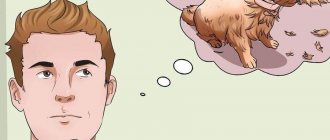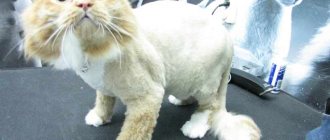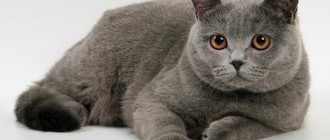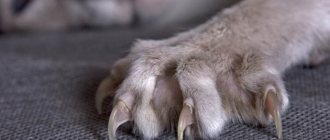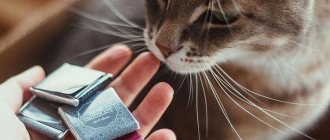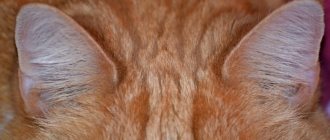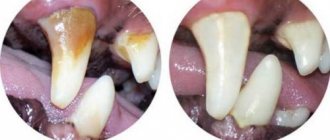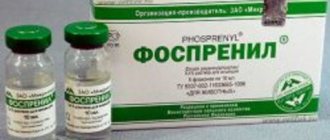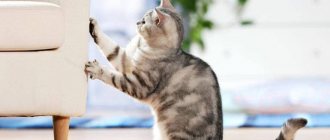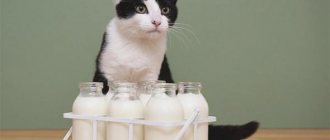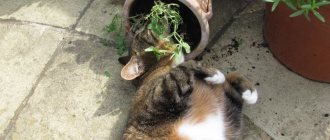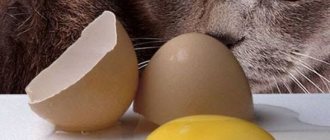Grooming cats will help keep their coat well-groomed in winter and summer. The procedure can be performed at home or in a salon or veterinary clinic. Fashionable hairstyles will allow you to brightly present your pet at an exhibition, and hygienic grooming will get rid of tangles and refresh the aesthetic appearance of the cat. To get a haircut correctly and safely, you need to know the rules and types of hairdressing services.
How often do cats get their hair cut?
Grooming of Scottish cats, British Fold cats, Siamese and other smooth-haired cats is not regular and mandatory; it is performed either for medical purposes (preparation for surgery or ultrasound diagnostics) or for an exhibition (artistic grooming). Grooming cats with semi-long fur is harmful if done more than twice a year. We must remember that hairstyle gives the animal not only stress from the process, but also discomfort in everyday life, since the pet feels the temperature differently, feeling “undressed”. Grooming short-haired pets is harmful and not recommended.
Who is doing?
Decoration from animal fur can only be done by an experienced specialist in this matter.
Depending on the purpose of the haircut, it can be performed in different places. A veterinarian will trim the mats. The procedure is common in veterinary clinics, but it is also performed by a cat groomer in a salon. Complex types of artistic hairstyles and work with dense, long and thick fur, cutting Siberian, Norwegian and Persian cats is done only in zoo hairdressers. Decorative haircuts for cats should be performed by a groomer; it is better not to try to cut your pet’s hair artistically on your own - the cost of a mistake is too high.
Animals cannot be groomed with a regular human machine. It is permissible for people to trim a cat using hairdressing equipment in an emergency and provided that the trimmer has at least 30 watts of power and the blades are ultra-sharp.
Cat Grooming Tools
The tools used differ in operating principle, power, and design. For regular home “beauty sessions”, it is important to take care of purchasing all the necessary equipment in advance. This requires special devices designed for animals. A cat clipper will be noticeably different from a “human” one.
Cars
A universal tool that is useful for grooming cats, removing mats, creating an attractive look, as well as regular pet care.
Classification of machines:
- By type of work: manual and automatic. You can only get an even haircut with automatic models, but they can frighten the animal with loud sounds or vibration.
- By type of power: mains or battery. It all depends on personal preference and choice. To ensure the battery holds its charge well, the machine should be used more often. On the other hand, networking equipment usually has higher power and performance, making it worth the purchase for owners of multiple pets.
- By power (for electric models): up to 15 W for short-haired pets, up to 30 W for medium-haired or thin-haired pets, up to 45 W for long-haired breeds.
- Additional parameters: brand reputation - manufacturer, warranty period, reasonable cost, engine volume when turned on.
Along with clippers for cats or other animals, there are specialized trimmers. They are small in size and powerful, so they are not suitable for full care. With the help of these devices, you can maintain the required level of hygiene by clipping certain areas or getting rid of mats in cats.
Scissors
Trimming fur yourself using scissors is practically not practiced. This is extremely difficult, especially with a restless pet, and requires special skills and extreme caution. Scissors for cutting hair must have very sharp blades, which in inexperienced hands increases the risk of accidental injury to the pet.
Can tools be used to cut a person's hair?
Hairdressing clippers or scissors do a good job of cutting cats only at first. Over time, the blades become dull, so thin fibers can easily slip between them. This creates certain difficulties. The tufts of hair will simply be torn out by the roots, so the pet will receive a lot of additional stress from the procedure. For medium-haired breeds with fairly coarse hair, “human” tools can be an excellent alternative, but not for long-haired cats. Despite the fact that purchasing a specialized tool will require additional financial investments, the costs will quickly pay off, because the services of a professional groomer will cost much more in the future.
Haircut options
The initial reason why the cat decided to correct the appearance of her fur coat dictates the choice of the type of grooming. According to purpose, cat grooming is divided into the following types:
- hygienic;
- medical;
- artistic (modeling, decorative hairstyles).
Hygienic
This method is used if the animal has accumulated a lot of tangles and they cannot be combed out.
When combing cats no longer saves them from tangles, a hygienic haircut will help rid the animal of clumps of stray hair. Regular trimming of caked fur is not difficult; you can trim a long-haired kitten or an adult cat yourself at home if you have the appropriate tools and minimal skills. The degree of hygienic grooming varies: if there are numerous lumps, cats are cut bald; if the coat is not very matted, problem areas with tangles are simply shaved off.
Model
Unusual fashionable options for the design of fur are made for pets for exhibitions, photo shoots, and just “for fun.” You can choose creative cat haircuts by visiting a pet salon. The traditional model treatment of the Persian and fluffy red cats as a lion is good. Semi-long white kittens are decorated in the style of teddy bears. The white purr is also cut to look like a poodle. Professional artistic grooming of Angora cats, fluffy Persians, British, Scottish and exotic cats should be performed exclusively by a master.
Why do cats get their hair cut? Types of haircuts
Popular long-haired breeds often require special care. The fur must be regularly combed, washed with special shampoos, and also trimmed. Cat grooming will provide coat renewal, comfort in the summer, as well as painless removal of old fur or mats.
Types of haircuts:
- Hygienic treatment, in which tangles are removed, is necessary for the well-being of the pet.
- Aesthetic, the main goal of which is to improve the appearance of the animal.
Grooming of cats is necessary in preparation for participation in an exhibition, to alleviate the condition of the animal after illnesses, remove tangles, reduce discomfort or the risk of overheating in the hot season.
Hygienic
The procedure involves comprehensive measures for hair care, cleaning, removal of tangles, and additional cosmetic procedures.
The main goals of a hygienic haircut:
- Maintaining good coat condition, removing dead hair.
- Helping weakened and old animals.
- Normalization of skin thermoregulation, reducing the risk of overheating in summer.
- Necessary measures when identifying certain parasitic infections, as well as skin diseases.
- Hygiene of the groin area in long-haired breeds.
- Care for hair prone to tangling and kinks.
- Facilitation of access before medical procedures.
The frequency of hygienic grooming of cats depends on the characteristics of the coat, the need for additional care, and the capabilities of the owners. Despite the fact that professional care is possible only with the help of specialists, it is also possible to provide the animal with similar procedures at home.
Aesthetic
More and more breeders and simply cat owners prefer to seek professional help when creating original “hairstyles” for their pet.
Why do you need an aesthetic haircut for cats?
- Preparation before exhibitions.
- Creating an original image.
- Preparing for spectacular photo sessions.
There is no special need for this; it is rather the whim of the owner, his personal preferences. Although such manipulations do not harm the animals, it is also important to consider the frequency of sessions, as well as the possible stress associated with the procedure.
General rules
You can work with the hair of some animal breeds with scissors.
To be safe, new haircuts for cats are done according to certain standards and recommendations. you should know who and how you can groom. It is allowed to cut a Persian cat and a pet with another long-haired breed using scissors, a mechanical hand or an electric machine. A Scotsman or a Briton can only be groomed with a machine, and scissors cannot be used to work with the hair of a Siamese cat. At the end of the process, the animal is bathed in warm water to remove small clipped hairs.
After the haircut, the cat should receive positive emotions in the form of a soothing, gentle stroking and tasty treats - this way the fright will go away faster. If the pet is shaved bald, the discomfort and anxiety will subside when the cat grows new fur 3-5 mm long, so that the animal does not attack its own tail, not perceiving it as its own, a brush is always left at the end.
Safety of the procedure
The absence of injuries is one of the main criteria for professional work. The fur is usually removed against the grain, but shaving the pet’s coat in the opposite direction is also acceptable, especially if these are small kittens or nervous adult purrs. Grooming according to hair growth makes it possible to avoid causing additional discomfort and stress to the animal. Before treatment with a machine, the tummy is carefully trimmed with scissors, paying special attention to the nipple area so as not to damage them.
A special collar is necessary for animals that are prone to nervousness and aggression during grooming.
If the animal is nervous, put on a collar and groom without anesthesia. A pet wearing a collar does not see what is happening and is less nervous; besides, this way it will not be able to bite the hairdresser. Particularly aggressive patients are groomed with immobilization - the master's assistant firmly holds the cat by the paws and head, not allowing him to twitch and interfere with the process. If there are a large number of mats and it is necessary to completely cut off the fur, the “aggressor” must be groomed under anesthesia.
How to properly groom cats at home
The procedure at home usually raises many questions. It is important to prepare well in advance, to calm the animal, minimizing possible stress.
What you will need:
- Comfortable, stable surface. A high table, chest of drawers, ironing board will do.
- Suitable equipment, including a machine or trimmer, comb, care products.
- Antiseptic preparations for treating accidental cuts.
It is advisable to combine a beauty session with other cosmetic procedures: trimming nails, treating eyes and ears.
Sequencing:
- Calm the pet and lay it on its side. It is advisable that an assistant be present during the session - a person familiar to the pet.
- The movements of the instrument are against the growth of hairs (less often in the opposite direction). Processing order: sides, back, belly.
- The ends of the paws, head and tail are the most difficult to trim, so doing it yourself often involves the appearance of a “lion.”
- When cutting, be sure to stretch the skin to avoid cuts. You can additionally use scissors to trim long hair and tangles.
- After treatment, you can profile the hairs and comb out the undergrowth well.
- Be sure to bathe the cat, removing remaining hairs and trimming uneven edges.
The nozzle used must be at least 3 mm. Particular care should be taken when trimming the belly and face. If the animal shows increased anxiety during the procedure, it is advisable to use treats or distracting toys; a protective cap often helps.
